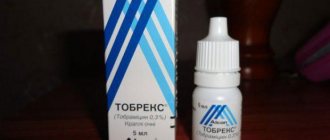Oftamirin eye drops are widely used in ophthalmology to eliminate infectious eye lesions. The drug is also highly effective in the prevention of infectious complications, which often occur after injuries, burns and surgery. "Oftamirin" is as safe as possible for the human body, so it can be used even by newborns in order to prevent the development of ophthalmia.
Compound
active ingredient:
miramistin;
1 ml of solution contains miramistin 0.1 mg;
Excipients:
sodium chloride, disodium phosphate dodecahydrate, sodium dihydrogen phosphate dihydrate, water for injection.
Dosage form.
Eye/ear/nasal drops.
Basic physical and chemical properties:
colorless transparent liquid.
Pharmacotherapeutic group.
Drugs used in ophthalmology and otology. Decongestants and other drugs for topical use for diseases of the nasal cavity. ATX code S03D, R01A.
Features of the drug
Eye drops "Oftamirin" suppress the activity of pathogenic microorganisms. The drug has a selective effect. When using "Oftamirin", the integrity of the cells of the human body is not compromised.
The scope of use of the drug is wide. This is due to the fact that miramistin, present in its composition, has immunomodulatory and antimicrobial properties.
This substance helps strengthen the body's protective functions. The active substance of the drug is not able to penetrate the general bloodstream.
Pharmacological properties
Pharmacodynamics.
Miramistin is a cationic surfactant with antimicrobial (antiseptic) effect.
The action of miramistin is based on the direct hydrophobic interaction of the molecule with the lipids of the membranes of microorganisms, leading to their fragmentation and destruction. In this case, part of the miramistin molecule, plunging into the hydrophobic portion of the membrane, destroys the supra-membrane layer, loosens the membrane, increases its permeability to high-molecular substances, changes the enzymatic activity of the microbial cell, inhibits enzyme systems, which leads to inhibition of the vital activity of microorganisms and their cytolysis.
Unlike other antiseptics, Miramistin has a highly selective action against microorganisms, since it has virtually no effect on human cell membranes. This effect is associated with a different structure of human cell membranes (much longer lipid radicals, which sharply limit the possibility of hydrophobic interaction of miramistin with cells).
Miramistin has a pronounced antimicrobial effect against gram-positive and gram-negative, aerobic and anaerobic, spore-forming and asporogenous bacteria in the form of monocultures and microbial associations, including hospital strains with multidrug resistance to antibiotics.
It has a detrimental effect on pathogens of sexually transmitted diseases - gonococci, Treponema pallidum, Trichomonas, chlamydia, as well as herpes viruses, human immunodeficiency, etc. It has an antifungal effect on ascomycetes of the genus Aspergillus
and genus
Penicillum
, yeast (
Rhodotorula rubra, Torulopsis gabrata,
etc.) and yeast-like (
Candida albicans, Candida krusei,
etc.) fungi, dermatophytes (
Trichophyton rubrum, Trichophyton mentagrophytes, Trichophyton verrucosum, T. schoenleini, T. violaceum, Epidermophyton Kaufman-Wolf, E. floccosum, Microsporum gypseum, Microsporum canis,
etc.), as well as other pathogenic fungi (for example
Pityrosporum orbiculare
(
Malassezia furfur
) in the form of monocultures and microbial associations, including fungal microflora with resistance to chemotherapeutic drugs. Under the influence of miramistin, the resistance of microorganisms to antibiotics is reduced.
Miramistin has anti-inflammatory and immunoadjuvant effects, enhances local protective reactions, regenerative processes, activates nonspecific defense mechanisms due to modulation of the cellular and local humoral immune response, which accelerates recovery.
Pharmacokinetics.
Miramistin has a local effect. There are no data on the possible penetration of the drug into the systemic circulation.
Clinical characteristics.
Special Cautions
Use during pregnancy or breastfeeding.
The drug can be used during pregnancy or breastfeeding.
The ability to influence the reaction rate when driving a vehicle or working with other mechanisms.
The drug does not affect the speed of reactions when driving vehicles or operating other mechanisms.
Children.
The drug is used in pediatric practice.
Indications
In the complex treatment of infectious processes in the anterior part of the eye (blepharitis, conjunctivitis, keratitis, keratouveitis) caused by gram-positive and gram-negative bacteria, chlamydia, fungi and viruses sensitive to miramistin, eye injuries, eye burns (thermal and chemical).
Prevention of ophthalmia of newborns, including gonococcal and chlamydial.
Prevention and treatment of purulent-inflammatory eye lesions in the pre- and postoperative period.
In the complex treatment of acute and chronic external otitis, chronic purulent mesotympanitis, otomycosis.
In the complex treatment of acute rhinitis.
Reviews
Oftamirin boasts a huge number of positive reviews. Patients call the main advantages of these drops the almost complete absence of side effects and contraindications, ease of use and high efficiency. They claim that the symptoms of eye infections disappeared without a trace after just a couple of days of using Oftamirin.
At the end of this article you can read more detailed reviews left by people who have used Oftamirin. Well, if you have ever been prescribed this drug, please share your opinion about Oftamirin with other readers.
Directions for use and doses
Ophthalmology.
For the treatment of infectious processes in the anterior part of the eye
adults and children over 12 years old are instilled into the conjunctival sac, 2-3 drops, children under 12 years old - 1-2 drops 4-6 times a day. The duration of treatment usually does not exceed 2 weeks.
In order to prevent complications in the pre- and postoperative period -
2-3 drops 3 times a day 2-3 days before surgery. After surgery - for 3-5 days, 1-2 drops 3 times a day.
In the treatment of eye burns
, after washing the eye with plenty of water, carry out frequent instillations (every 5-10 minutes) for 1-2 hours. For further treatment, use the drug for adults and children over 12 years old - 2-3 drops, for children under 12 years old - 1-2 drops 4-6 times a day.
For the prevention of ophthalmia in newborns
Immediately after birth, the child should instill 1 drop of the drug into each eye 3 times with an interval of 2-3 minutes.
Otolaryngology.
In the treatment of acute and chronic external otitis, otomycosis
adults and children over 12 years of age, instill 3-5 drops 4-6 times a day;
children under 12 years old – 2-3 drops 4-6 times a day.
A gauze turunda moistened with a medicine can be inserted into the external auditory canal 4-6 times a day for 10-14 days (instead of instillation).
For chronic mesotympanitis
used in complex treatment using hardware ultrasonic irrigation or injection into the tympanic cavity together with antibiotics.
In the treatment of acute rhinitis, infection of the nasal mucosa
instill 2-3 drops in adults and children over 12 years old, 1-2 drops in each nasal passage for children under 12 years old 4-6 times a day. The course of treatment is 7-14 days.
Dosing features.
Precise dosing is achieved by pressing the bottom of the bottle - 1 press = 1 drop.
Children.
The drug can be used in pediatric practice.
In the presence of what pathologies is the use of the medicine indicated?
"Oftamirin" is used for the following indications:
- The presence of an inflammatory process in the anterior part of the eyes,
- Injury to the organs of vision.
It is advisable to use “Oftamirin” to prevent the development of ophthalmia in newborns and to prevent the occurrence of adverse consequences after surgical procedures.
Causes and symptoms of ophthalmia of newborns
Ophthalmia in infants is quite severe. Redness of the eyes occurs, swelling of the eyelids is observed, and purulent discharge often appears. The main cause of the pathology is bacterial infections that are transmitted to the child from the mother during childbirth.
To prevent the occurrence of ophthalmia in newborns, drugs such as “Oftamirin”, ointments with an antibacterial effect, are used.
Note! With ophthalmia, eye irritation occurs and profuse lacrimation occurs. Redness of the eyes in a newborn can also be caused by the use of Albucid and other medications used for preventive purposes.
Ophthalmia in newborns can be characterized by the following symptoms:
- Swelling of the eyelids,
- Increased sensitivity to light,
- The appearance of a white film on the eyes,
- The appearance of purulent discharge in the morning.
Note! With ophthalmia of the newborn, pinpoint hemorrhages may also occur.
When exposed to gonococcus, acute purulent inflammation occurs in the conjunctiva, blenorrhea. As a result, the eyelids swell and turn bluish, and bleeding of the mucous membrane of the affected eyes may occur.
In the presence of gonococcal blenorrhea, the risk of infection entering the cornea and a sharp deterioration in vision increases.
In order to prevent the occurrence of ophthalmia in newborns, it is necessary to promptly treat urogenital infections in pregnant women. In the maternity hospital, the birth canal of women in labor is treated with medications that have a pronounced antiseptic effect.
Blepharitis
With blepharitis, inflammation occurs in the area of the edges of the eyelids. The disease causes discomfort, pain and a burning sensation. Blepharitis, in the complex therapy of which “Oftamirin” is used, can provoke visual impairment. In some cases, the disease leads to the development of keratitis.
The following factors increase your risk of developing blepharitis:
- Avitaminosis,
- Prolonged stay in a dusty room,
- The presence of demodicosis of the eyelids,
- Pathologies of the digestive tract,
- Using low quality cosmetics,
- The presence of foci of chronic infection in the body: sinusitis, carious teeth.
The main manifestations of blepharitis include:
- Eye fatigue
- Increased eye sensitivity to irritants (wind, sun rays),
- Itching occurs
- Redness of the eyelids
- Decreased vision clarity due to the formation of tear film in the eyes,
- Gluing eyelashes.
If a patient has blepharitis, the blood supply to the eyes deteriorates, which causes the following complications:
- Doubling of objects before the eyes,
- Swelling of the eyelids,
- Loss of eyelashes,
- Increased lacrimation.
Important! If blepharitis is caused by exposure to allergens, the following symptoms may occur: severe burning, a feeling of “sand” in the eyes, itching.
Keratitis
"Oftamirin" is also used in the treatment of keratitis. The main causes of the disease are injuries, allergic reactions, and infectious diseases. If the patient has keratitis, visual acuity may decrease. The pathology is often a consequence of inflammatory eye diseases such as blepharitis and conjunctivitis.
In the presence of keratitis, infiltrate accumulates in the tissues of the cornea. This leads to damage to the nerve endings and a decrease in the transparency of the cornea.
Keratitis causes a sensation of a foreign body in the eye. Blepharospasm may also be observed.
Keratitis leads to the following complications:
- Deterioration of visual acuity due to corneal clouding,
- Glaucoma,
- The appearance of phlegmon in the orbital area,
- The appearance of signs of herpetic keratoiridocyclitis,
- The appearance of an eyesore.










